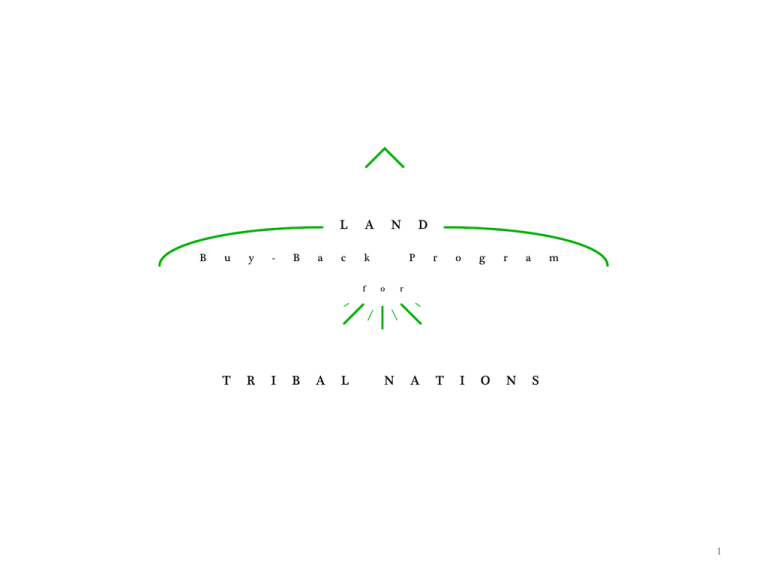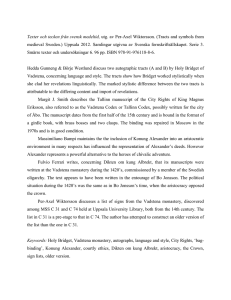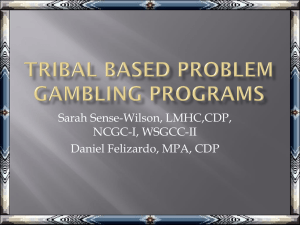Land Buy Back Program
advertisement

B u y - B a L A c k f T R I B A L N o N D P r A T o g r O N a m r I S 1 Presentation Summary Program Overview Implementation Plan Overview Outreach Land Research and Valuation Land Acquisition Program Rollout Tribal Involvement 2 Program Overview – Background • The Buy-Back Program is a collaborative effort - involving Interior, tribes, and individuals - to reduce the number of fractional interests in tracts of trust or restricted lands. Fractionated tracts are defined as any tract with more than one landowner. • Settlement background and intentions. • Purchases are voluntary. • No liens - lands will stay in trust or restricted status and be transferred to the tribe that has jurisdiction over the land, without any liens attached. 3 4 Program Overview: Organizational Structure • The Buy-Back Program is headed by a Program Manager (John McClanahan) in the Office of the Secretary who reports to the Deputy Secretary. • Oversight Board provides policy guidance, ideas for improvement, oversight, and other assistance to the Buy-Back Program. The Deputy Secretary chairs the Board: • Kevin Washburn, Assistant Secretary - Indian Affairs • Hilary Tompkins, Solicitor • Michele Singer, Principal Deputy Special Trustee for American Indians • Michael Black, Director, Bureau of Indian Affairs • Andrew Jackson, Deputy Assistant Secretary - Technology, Information and Business Services • Neil Kornze, Principal Deputy Director, Bureau of Land Management • Acquisitions Director in the Bureau of Indian Affairs (BIA). • Deputy Director for Valuations in the Office of the Special Trustee for American Indians (OST). 5 Program Overview: Organizational Structure Program Overview: Scholarship Fund • Cobell Settlement Agreement also provides for an Indian Education Scholarship Fund to provide financial assistance to native American students attending post-secondary vocational and college institutions. • Three avenues for funding: 1) Consolidation Incentive Payments – Trust Land Consolidation Fund; 2) Accounting/Trust Administration Fund Balance; and 3) Unclaimed Whereabouts Unknown Payments. • Consolidation Incentive Payments (up to $60 million) will be automatically calculated through TAAMS and transferred to the fund on a quarterly basis per Settlement Agreement: • For every purchase of a fractional interest costing less than $200, $10 will be added to the Scholarship Fund. • For purchases costing between $200 and $500, $25 will be added to the Scholarship Fund. • For purchases over $500, 5% of the purchase price will be added to the Scholarship Fund. • The Scholarship Fund will not be managed by the Department or Buy-Back Program; it will be managed by the non-profit organization American Indian College Fund. 7 Implementation Plan: Overview • Interior issued an Initial Implementation Plan on December 18, 2012, after incorporating feedback from consultation on a draft plan dated January 2012. • This plan is available on the web at: http://www.doi.gov/buybackprogram. • Incorporates previous feedback and consultations. • The Program also received feedback on the plan during 2013 consultations and will be responding to the comments in the coming weeks. 8 Implementation Plan: Overview • There are about 150 reservations with 92,000 fractionated tracts containing 2.9 million fractional interests. These interests are owned by approximately 219,000 individuals. • Ninety percent (90%) of the fractional interests are located in 40 locations. • Under the Settlement, only fractional interests in trust or restricted lands will be purchased. (Fee lands will not be purchased.) • There will be NO forced sales. The Buy-Back Program will only purchase interests from landowners willing to sell their fractional interests. 9 Implementation Plan: Purchase Ceilings • In response to tribal feedback, preliminary purchase ceilings are proposed in the Initial Implementation Plan, based on the level of fractionation (a location’s proportional amount of fractionated tracts, acres, and interests). • Dollar amounts tentatively suggested as purchase ceilings are flexible and subject to change due to tribal feedback and as the Buy-Back Program evolves. • Actual purchase amounts at any reservation depend on the number of individuals that decide to sell fractional interests at that location. 10 Implementation Plan: Purchase Ceilings Rank Land Area Name BIA Region Number of Fractionated Tracts Associated Acres Number of Purchasable Fractional Interests Weighted Proportion Estimated Initial Purchase Ceiling 1 Pine Ridge Great Plains 5,982 1,194,669 194,401 8.11% $126,110,500 2 Standing Rock Great Plains 6,268 761,758 214,947 7.09% $110,249,500 3 Blackfeet Rocky Mountain 4,793 892,122 188,894 6.67% $103,718,500 4 Crow Rocky Mountain 4,803 922,907 177,530 6.64% $103,252,000 5 Navajo Navajo 4,355 685,949 255,472 6.62% $102,941,000 6 Fort Peck Rocky Mountain 4,481 718,048 113,183 5.15% $80,082,500 7 Cheyenne River Great Plains 4,026 730,114 64,833 4.48% $69,664,000 8 Gila River Western 4,669 83,840 172,551 3.90% $60,645,000 9 Rosebud Great Plains 3,068 560,021 90,734 3.89% $60,489,500 10 Fort Berthold Great Plains 3,208 464,106 90,976 3.64% $56,602,000 11 Fort Belknap Rocky Mountain 3,007 570,883 55,329 3.50% $54,425,000 12 Wind River Rocky Mountain 2,514 172,503 136,834 3.00% $46,650,000 13 Fort Hall Northwest 2,574 268,830 50,968 2.35% $36,542,500 14 Yakama Northwest 2,190 175,135 53,239 1.94% $30,167,000 15 Colville Northwest 2,039 165,298 35,939 1.66% $25,813,000 16 Sisseton - Wahpeton Great Plains 1,316 93,018 52,882 1.37% $21,303,500 17 Minnesota Chippewa Midwest 979 60,213 71,139 1.35% $20,992,500 18 Quinault Northwest 1,421 103,823 35,838 1.24% $19,282,000 19 Spirit Lake Great Plains 932 56,261 60,075 1.19% $18,504,500 20 Chickasaw Nation Eastern Oklahoma 1,882 111,219 14,297 1.19% $18,504,500 21 Winnebago Great Plains 642 35,888 74,105 1.19% $18,504,500 22 Cheyenne Arapaho Southern Plains 1,129 96,787 39,264 1.16% $18,038,000 23 Salt River Western 1,403 21,673 48,562 1.12% $17,416,000 24 Crow Creek Great Plains 902 98,139 43,217 1.12% $17,416,000 25 Ute Western 1,058 76,738 43,547 1.12% $17,416,000 26 Yankton Great Plains 778 45,248 38,730 0.86% $13,373,000 27 Northern Cheyenne Rocky Mountain 889 104,594 15,284 0.82% $12,751,000 28 Lower Brule Great Plains 594 76,257 30,242 0.80% $12,440,000 29 Umatilla Northwest 1,014 66,832 18,701 0.79% $12,284,500 30 Turtle Mountain Great Plains 582 32,924 25,806 0.61% $9,485,500 31 Seminole Eastern Oklahoma 952 37,627 8,022 0.55% $8,552,500 32 Bad River Midwest 617 29,440 20,382 0.55% $8,552,500 33 Nez Perce Northwest 622 44,498 12,083 0.50% $7,775,000 34 Ponca Southern Plains 403 20,882 25,149 0.50% $7,775,000 35 Washoe Western 409 59,310 14,073 0.49% $7,619,500 36 Muscogee (Creek) Eastern Oklahoma 780 45,130 5,528 0.49% $7,619,500 37 Osage Eastern Oklahoma 609 73,434 2,988 0.48% $7,464,000 38 Salish & Kootenai Northwest 693 38,409 9,250 0.48% $7,464,000 39 Omaha Great Plains 421 22,022 21,374 0.46% $7,153,000 40 Fort Yuma Western 708 6,879 13,060 0.42% $6,531,000 Total Top 40 79,712 9,823,427 2,639,428 89.51% 1,391,569,500 Remaining Reservations 12,862 800,577 294,603 10.49% $163,430,500 Overall Total 92,574 10,624,004 2,934,031 100.00% $1,555,000,000 11 Implementation Plan: Major Phases There are four phases to the Buy-Back Program when implementation occurs at a particular reservation: 1. Outreach to advertise the Buy-Back Program, find willing sellers, and get Tribal priorities as to what type of fractionated tracts they wish to have purchased. 2. Land Research to collect data necessary to establish fair market value for fractionated tracts that might be acquired. 3. Land Valuation to determine the fair market value of tracks where Interior will offer to buy fractional interests. 4. Land Acquisition to purchase interests in fractionated tracts valued in phase 3 that individuals would like to voluntarily sell. 12 Outreach Phase: Goals The Outreach Phase will have two primary goals: 1. Interior officials will meet with tribal governments and individuals to discuss: a. Tribal priorities for acquisition b. How best to conduct outreach on the reservation c. Tribes interest and capacity to conduct Buy-Back Program operations through cooperative agreements d. Implementation timeframe at each location (goal is 18-24 months) 2. Inform individuals owning fractional interests of the details of the BuyBack Program and how they may participate in the Program if they so desire. 13 Land Research Phase • The Land Research Phase will utilize information from the Trust Asset and Accounting Management System (TAAMS) system. • The Land Research Phase will focus on collecting data necessary to make fair market value determinations during the Valuation Phase. • Tract land uses or acreage types, such as range/grazing, dry farming, irrigated farming, or forestry will be noted in this phase. • GIS capabilities will be instrumental to this phase. 14 Land Valuation Phase • The Office of the Special Trustee for American Indians (OST), Office of Appraisal Services (OAS) will be responsible for the appraisal of the tracts, incorporating any contributory value from timber and mineral estates. • The Office of Mineral Evaluations (OME) will be responsible for the valuation of mineral interests. • Land Valuation will rely heavily on mass appraisal valuation techniques. • Mass appraisal valuation techniques will be used to reduce administrative costs, expedite the appraisal process, and enable the most offers possible. • Certain tracts may not be amenable to mass appraisal valuation techniques, which may preclude purchase of fractional interests in these tracts. 16 Land Acquisition Phase • In order to be efficient, Interior proposes a one-step offer process. • Purchase offer packages will be generated & mailed to individuals owning fractional interests in tracts valued by the Program. This packet will include: • Cover Letter; • Instruction sheet; • Deed and Purchasable Interests Report (next page); and • Map(s). • Base Payment – Consistent with tribal feedback, Interior will provide landowners with a base payment of $75 per offer, regardless of the value of the land. Recognizes the time and effort required for individual landowners to proceed through the acquisition process. 17 Sample Purchasable Interests Report United States Department of Interior Bureau of Indian Affairs Exhibit A - Purchasable Interests Inventory (PII) Date: (MM/DD/YYYY) Grantor ID: Grantor Name: Page # of # Offer/Deed ID#: ######## ########## XXXXXXX XXXXXXXXXX Reservation/Land Area Name: XXXXXXXXXXXXXXXXXXXX Base Payment: In addition to the owner interest value price offered for any, all or some of the tracts listed in thi s report and chosen by you to sell, you will receive $ 75.00 for completing the purchase offer package and deed. Sell Example: Please use black or blue ink and fill in the circle(s) completely on the individual tracts you wish to sell, or you may select the “Sell all Tracts Listed Below” Total Total Owner Tract Matching BIA Legal Tract Tract Owner Interests Appraisal Scholarship Tract ID Tract Name Description Resource Acreage Interest (%) Value Date (Barcode) Contribution1 Sell All Tracts Listed Below Total of All Owner Interests Value: $496.95 999 345 Walking Crane S12,T12N,R2W Surface County, ST Only 80.00 .289% $389.20 XX/XX/XXXX||||||||| $10.00 999 650-B Two Rivers 40.00 .024% $74.50 XX/XX/XXXX||||||||| $10.00 999 780 Spotted Horse S32,T21N,R4W Surface & County, ST Mineral 160.00 .003% $33.25 XX/XX/XXXX||||||||| $10.00 S25,T18N,R2W Surface & County, ST Mineral Total Scholarship: $30.00 (Barcode) |||||||||||||||||||| Offer/Deed ID # ######## 1 The Claims Resolution Act of 2010 authorized matching contributions up to $60 million, made to the Indian Education Scholarsh ip Fund for each ownership interest purchased. A zero dollar amount in this column indicates that the Fund has reached $60 million and no further matching contributions are being made. 18 Land Acquisition Phase • Interior wants to send offers to as many individuals as possible. • If the value of the tracts appraised for a particular location far exceeds the purchase ceiling amount, prioritization becomes especially important. • Possible factors to determine/prioritize the offers to be made include: • • • • • Tribal Priority Tracts Level Fractionated Ownership Tract Values Interested/Willing Sellers Other criteria/factors (TBD) 19 Land Acquisition Phase • Landowners will have a set amount of time to decide whether to sell some or all of their fractional interests that were valued (45 days). • Staff at local field offices will be available to answer questions or assist with completing the packet. • Payments will be made into the IIM account of the landowner for those who decide to sell. • The Program will attempt to contact Whereabouts Unknowns (WAU’s) for a period of 5 years, after which the landowner will be considered to have consented to the sale. 20 Program Rollout • Active at each location for a limited period of time (approximately 18 months), given time and cost limits and goal of buying at many locations. • Identification of key criteria (e.g., fractionation severity, ownership overlap, geographic diversity, appraisal complexity, tribal readiness, availability of resources). • Initial efforts with up to approximately 10 locations. • Outreach and communication efforts to promote tribal involvement, build awareness, and encourage sales. • Steady stream of information shared with tribes and the public. 21 Program Rollout • Initial efforts will allow the Program to confirm its planning assumptions, gauge the effectiveness of operating processes and procedures, and incorporate lessons learned into future activities/locations. • Goal is to have a fairly diverse group of reservations in order to determine what procedures work best, or do not work, under a variety of factual circumstances and conditions. • Mix is likely to provide the lessons necessary to implement the program quickly, efficiently, and effectively, within the allotted time period on as many of the 150 locations as possible. 22 Tribal Involvement • Tribal involvement will be critical to the success of the Buy-Back Program. • Tribes will be involved in the Program in various ways: • Tribal Priorities - Tribes will be able to identify tracts of land as priorities for acquisition (acquisition depends on willing sellers). • Cooperative Agreements will be entered into with tribes to conduct land consolidation activities required under the Buy-Back Program, especially in the area of outreach. (The provisions of the Self Determination Act do not apply.) 23 Tribal Involvement Steps and items necessary to establish a cooperative agreement include: • Joint planning • Scope of work • Standard forms requesting federal financial assistance • Statement(s)of work for proposed task(s), to include narrative and detailed budget(s) • Tribal resolution 24 Measuring Performance • Owner response rate to offers • Percent of purchase ceiling utilized • Acres added to tribal land base • Number of tracts brought to 50 or more percent tribal ownership • Other? 25 Questions? 26









